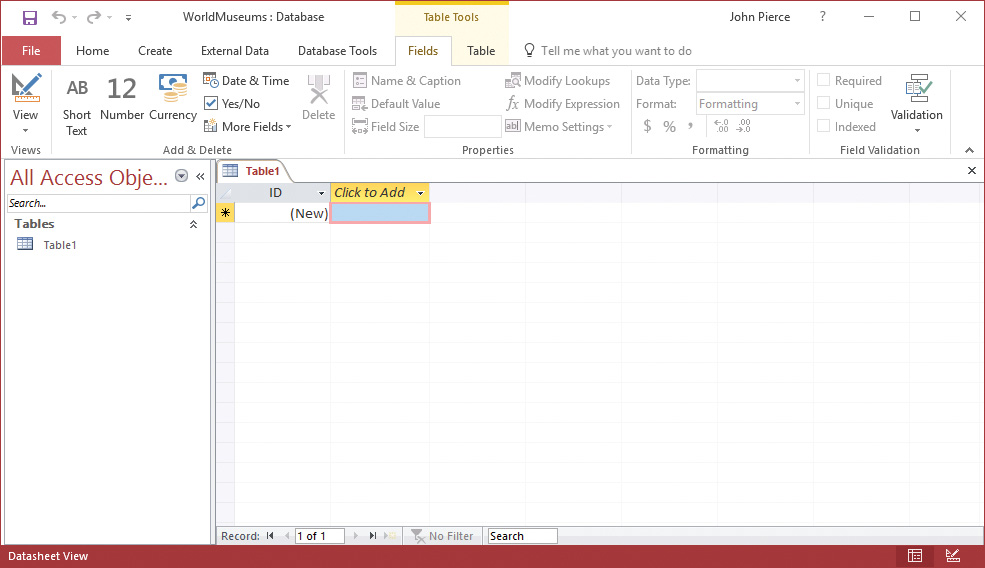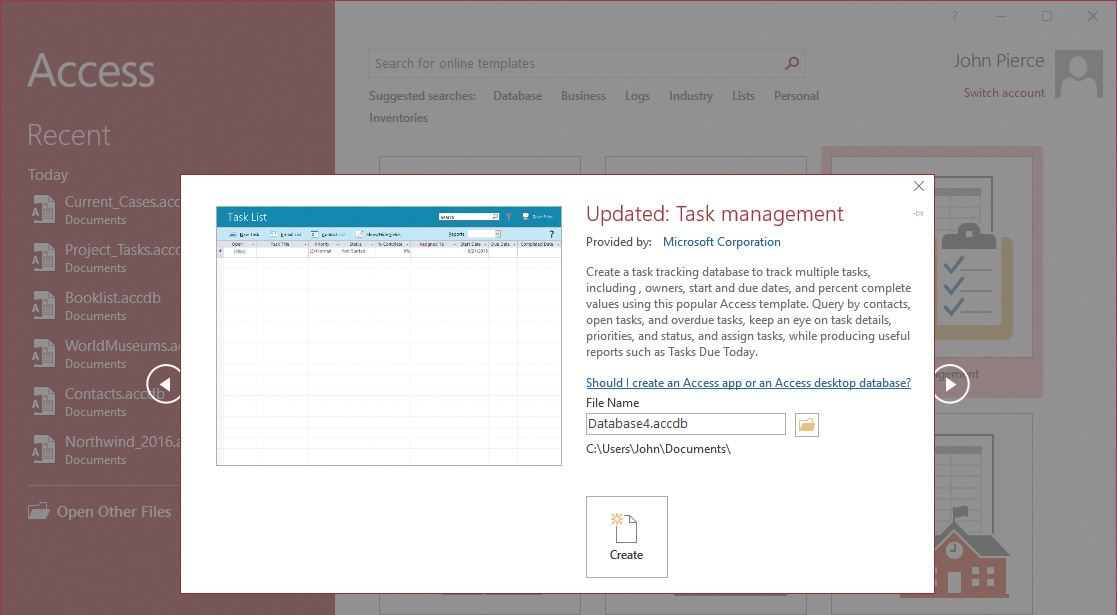Objective 1.1 Create and modify databases
- 1.1.1 Create databases
- 1.1.2 Import database objects and data
- 1.1.3 Delete database objects
OBJECTIVE 1.1: Contents
1.1.1 Create databases
Create databases
Access databases are made up of database objects: tables, queries, forms, reports, and supporting objects such as macros. Templates provide some or all of the database objects you need to manage the type of data the template is designed to support. When you create a blank database, Access provides a single table by default. You can set up and define other database objects to expand the databases you create. By default, Access names new database files by using Database n, where n is a number such as 1 or 2. You can enter a more descriptive name when you create the database.
Access provides templates for desktop databases and for what Access calls SharePoint web apps. (The thumbnails for web apps display a globe.) When you work with an Access web app, you work in a web browser, but you design and modify the web app in Access. You can share the data in a web app by using an instance of SharePoint.
Exam Strategy: Exam 77-730, “Access 2016: Core Database Management, Manipulation, and Query Skills,” does not require you to demonstrate that you can create an Access web app.
A blank desktop database opens with the Navigation Pane open. In a blank database, Access creates a default table, called Table1, which serves as a starting point. Access displays the default Table1 in what Access refers to as Datasheet view. When a table is displayed in Datasheet view, you can define field names and data types and insert records. You can also display a table in Design view. In Design view, you work directly with the structure of the table (the table’s field names and properties) instead of with the records stored in the table.

The Navigation Pane and Datasheet view of the default table in a blank desktop database
See Also: For more information about how to display objects in the Navigation Pane, see in “Objective 1.3: Navigate through a database.”
The database templates represented by the set of thumbnails that appears on the startup page are not the only database templates you can use. At the top of the startup window is the search box, with the prompt “Search for online templates,” and just below the search box are suggested search terms. You can search by using one of the suggestions or enter the search term you want to use in the search box to locate other templates that might be available.
When you select a thumbnail for a database template on the startup screen, Access displays a window that provides a description of the template.

Use the arrows that appear to the left and right of this window to browse through the set of templates
In most cases, when the new database opens, Access displays a table or opens a form for data input. Other objects in the database appear in the Navigation Pane. The Task Management desktop template, for example, includes tables that define records for contacts and tasks. This template also includes several queries used to analyze the data, forms for working with tasks and contacts, and several reports.
Tip: Access 2016 includes the Northwind Traders sample database, which has been part of Access for many versions of the program. The Northwind Traders database provides examples of features, including a login dialog box, sample macros, and Microsoft Visual Basic for Application (VBA) modules. Use the search box to find the Northwind Traders database template (the thumbnail identifies the database as Northwind 2007 sample). Create the database, and then refer to it when you’re looking for a solution, or just work with it from time to time to gain an understanding of the extent of the work you can do in Access.
To create a database from a template
1. On the startup screen or the New page of the Backstage view, click the thumbnail for the template you want to use.
- Tip: Use the search box to locate a template that’s not displayed. To create a blank desktop database, click the Blank Desktop Database thumbnail. (Depending on your installation of Access, the template might be named Blank Database or Blank Desktop Database.)
2. In the File Name box, enter a name for the database.
3. If you want to store the database in a location other than your Documents folder, do the following:
a. Click the folder icon to the right of the File Name box.
b. In the File New Database dialog box, navigate to the folder where you want to store the database.
c. Click OK.
4. Click Create. Access downloads the template if necessary, and then creates and opens the new database.
5. If an Info bar below the ribbon displays a security warning, click Enable Content.